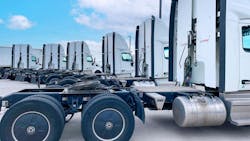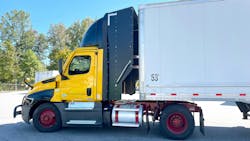TruckWings, the aerodynamic panels that help fleets improve fuel efficiency by reducing drag, recently surpassed a combined 1 billion miles on the road. This accomplishment comes just seven years after the first generation TruckWings were placed onto Class 8 tractors.
These billion road miles were achieved over several years, building off learnings from fleet trials and customer feedback, resulting in three generations of the TruckWings product.
Today, over 4,000 trucks are equipped with TruckWings, and this billion-mile milestone is just the beginning, TruckWings’ founder Dan Burrows told FleetOwner.
“We feel like we're just getting started,” Burrows said. “A billion miles is a lot for a new product, but it's a tiny fraction of what we want to do, and it's a tiny fraction of where we are going.”
ConMet, the company that produces the TruckWings, will continue to innovate, Burrows explained, working with customers to achieve fuel economy and efficiency improvements.
How do TruckWings create fuel savings?
As a product designed to improve a tractor-trailer's aerodynamics, the primary function of TruckWings is to reduce wind drag by closing the gap between the tractor and the trailer. This drag reduction creates better fuel economy—in some cases up to a 12% improvement under heavy crosswinds, though the company advertises an average 4.5% improvement.
“We certainly see [fleets] doing better than that, and not a lot worse,” Burrows told FleetOwner.
The wider the gap, such as the distance between a day cab and the trailer, the better the fuel economy improvement. For day cabs, specifically, driving more than 80,000 miles a year will typically produce a “very good ROI for you,” Burrows said.
See also: Day cabs can benefit from aero devices
Though this doesn’t mean TruckWings are only suitable for day cabs. While sleepers have a smaller gap between the tractor and the trailer, they typically travel more miles per year—sometimes double. Therefore, while the fuel efficiency gains experienced with TruckWings installed on a sleeper might be 3-4% (or half that of the savings experienced in a day cab), when multiplied by the actual number of miles driven, the savings are comparable.
One misconception about TruckWings—and trucking aerodynamics as a whole—is that for aerodynamic products to be effective, they must be used in long-haul applications, Burrows explained. Because TruckWings deploys only after the truck reaches highway speeds dictated by the truck owner, which for one fleet is 52 mph, this further enforces the misconception.
But regional-haul applications have also benefited from TruckWings, with the aero devices deployed on some regional-haul trucks for up to 85-90% of the time the truck is in use, Burrows told FleetOwner. This percentage of deployment helps determine a fleet’s actual or potential ROI.
“We ask fleets ... ‘When you’re on the highway, how fast are you going?’” Burrows said. “Then we say, ‘How many highway miles are you doing a year?’ And that’s how we build the ROI analysis for our fleets.”
Learning from the billion miles driven
Because of the trucking industry’s varied applications, it’s rare that any fuel efficiency product is a one-size-fits-all solution. The same can be said for TruckWings. However, where TruckWings do make sense, Burrows said the team wants to ensure that they are continuously improving the product, and that happens through customer feedback.
“The billion miles is ... not about traveling the miles,” Burrows said. “It's about learning from the miles and learning from our customers. Trucking has so many different applications and people doing different things, we really want to listen to customers and put that all back in [the product].”
Customer feedback drove innovations behind each generation of the TruckWings product. Examples include extending the life of wearable parts on TruckWings from 125,000 to 350,000 miles and adding a “soft close” feature to the actuators so that the TruckWings don’t bang shut against the sleeper cab when closed.
TruckWings also receive periodic over-the-air updates. One such update prevented drivers from manually deploying the TruckWings before backing into a trailer, potentially damaging the device. This update also came from customer feedback.
“I can look at every bit of the TruckWings system and see a customer's fingerprint on how we improved it,” Burrows said.
It’s also important that ConMet has conversations about fuel economy with its customers to share testing results and to be completely transparent, Burrows explained, because the TruckWings product isn’t the best fuel savings solution for every application.
“We love those conversations, and we learn as much from customers and share what we've learned from our testing,” Burrows told FleetOwner. “We think of it as a long-term game where we want to be helpful, and if there's a good application, we want to be a trusted partner at that point. But if there isn't, we will also say, like, ‘We're not going to improve your flatbeds today, but we have ideas about how you can improve your fuel economy.’ We always welcome those conversations.”
Finding more trucking efficiency while reducing emissions
Recent industry surveys have revealed that the current trucking economy has caused concern among fleet owners, with many looking for ways to increase operational efficiency for the sake of a healthier bottom line. Improving fuel economy by 4.5% or more using aerodynamic devices is one way to achieve greater operational efficiency.
TruckWings customers are hyper-focused on fuel economy, fuel savings, ROI, and strengthening their bottom line, especially with the stagnant economy and with low freight rates, Burrows explained. It was a focus on “dollars and cents” that Burrows used to sell his first units of TruckWings nearly 10 years ago.
See also: How AI is making fleets more efficient
But helping fleets successfully decrease their fuel spend isn’t the only benefit of TruckWings. The aerodynamic device also helps fleets decrease their emissions, which is a common request of fleet customers and, in some cases, a government requirement.
“I definitely see a really strong focus on ROI and the fuel economy savings ... with our customers, but they also want to see the carbon savings,” Burrows said. “And their customers are asking them, ‘What are you doing for carbon sustainability?’”
At a time when more environmentally friendly alternative fuels and powertrains have yet to prove themselves in many trucking applications or require extensive capital investment that fleets can’t afford, TruckWings customers can benefit from its sustainability features.
“We have fleets who’ve said, ‘I was told by my customers to do electric, but electric is really hard,’” Burrows explained. But “if you spec 25 TruckWings on your diesel fleet, that’s the same as running one electric truck.”
Burrows explained it this way: If one TruckWings-equipped diesel truck receives a fuel efficiency savings of 4%—which Burrows said is a conservative number—that savings multiplied by 25 trucks would be the equivalent of adding one completely zero-emission electric vehicle to the fleet.
“Twenty-five TruckWings in your fleet today is often seen by fleet managers as much easier to manage, much easier to update, and much cheaper to buy than an electric truck,” Burrows told FleetOwner.
1 billion miles is ‘a tiny fraction of where TruckWings is going'
The TruckWings team at ConMet “lives and breathes” fuel economy, Burrows told FleetOwner. The billion miles that the company already has under its belt will only continue to help TruckWings increase fleet efficiency—even in the EVs that some industry experts and some lawmakers want to be the future of trucking.
Electric trucks equipped with TruckWings have seen a 6-8% increase in efficiency, which Burrows said could help fleets better plan their infrastructure needs and manage their routes.
In the meantime, the TruckWings team is working to make it easier for fleet owners to equip their diesel trucks with TruckWings. With the help of ConMet, which recently acquired TruckWings, Burrows and his team are working to ensure that the aerodynamic devices can be more integrated into how fleets build and purchase trucks at the OEM level, since all fleets can benefit from an increase in fuel efficiency to boost their bottom line.
About the Author
Jade Brasher
Senior Editor Jade Brasher has covered vocational trucking and fleets since 2018. A graduate of The University of Alabama with a degree in journalism, Jade enjoys telling stories about the people behind the wheel and the intricate processes of the ever-evolving trucking industry.


